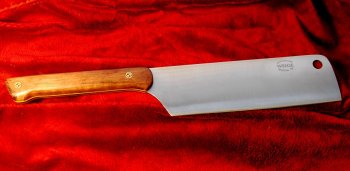WeigeKnives
Member
Great tip. Going to use a finished knife with vulcanized fiber in the house awhile and see what happens. I do like the idea of using a very thin layer of G10. That will sold the problem right off.
Thanks for the tip on the correct terminology. I'll take your advice on rounding the scales more next time. While it's rounded it could certainly be more round. I ran into a problem with the mosaic pins on this knife in that I was using the end of a tube and 1/4 inch of the pin wasn't showing up when I started cleaning up the handle. So I ended up having to make the handle thinner than I planned to bring the pin back. Pain in the butt. I finally got the pin to show through in it's entirety.
That is just so inconvenient, isn't it? This is why I make my own pins now... sure its more work, and its a bit of a headache, but this way I get exactly what I want and I know exactly what I have.
God Bless.
Nice size and I like the profile. FYI, Any material in between the tang and scales is usually called a "Liner"
The handle also looks nice, In the future you may want to round the scales to the tang a bit more so it's more comfortable for long term use..
All around you did great and the customer should be happy.
I worked on a new knife today and tried to round it out more. What do you think about this? It has a yellow vulcanized fiber liner, but this is the last knife I'm making with that material.
Weige,Just an FYI on cutting G10. Use a bimetal blade. I used a regular wood cutting blade to cut some 1/4" G10 stock and it tore the teeth off the blade then caught on a broken tooth and damaged the motor before it hit the off switch. That caused the motor to bog down more easily, and each time it did, it lost more power. Fiinally it would even cut a pine board and I had to replace the saw. Also, wear a respirator while working with it. You really don't want to breath the fibers cast off during the cutting. They can lodge in your lungs and not come out.
Doug
Mike awesome reply. Kellyw
Here is my take
Stabilized wood is great. Lot less finish work to get a great finish. Putting all those coats of finish oil takes a lot of time and you still have to sand it to the same grit. As state some woods would be worthless as knife handles without it. As stated some woods don't need it and many of those won't take stabilization anyway.
That being said. the are tonnes of walnut gun stocks out their that are very old and still in great shape. Same thing with natural knife handles. Part of it depends on the wood and another big part is how well the knife is taken care of. I wouldn't have a problem with a good walnut handle that was well finished with something like tung oil as long as it wasn't left in water or left laying in poor environments. Part of it is the knife and use. If I made a W2 blade with a hamon, or any other non stainless stainless steel for that matter I wouldn't really worry about stabilizing a set of walnut scales or any other solid dense hardwood for it. If not taken care of the beauty won't last anyway. What good are nice stabilized scales on a piece of rust.
